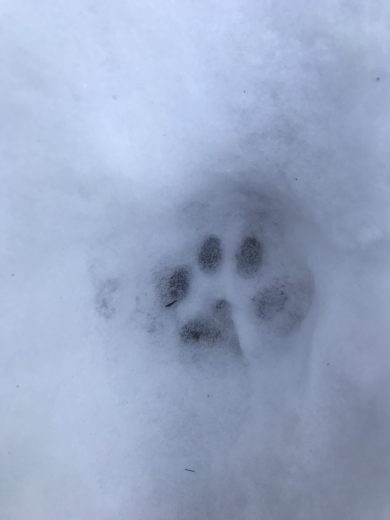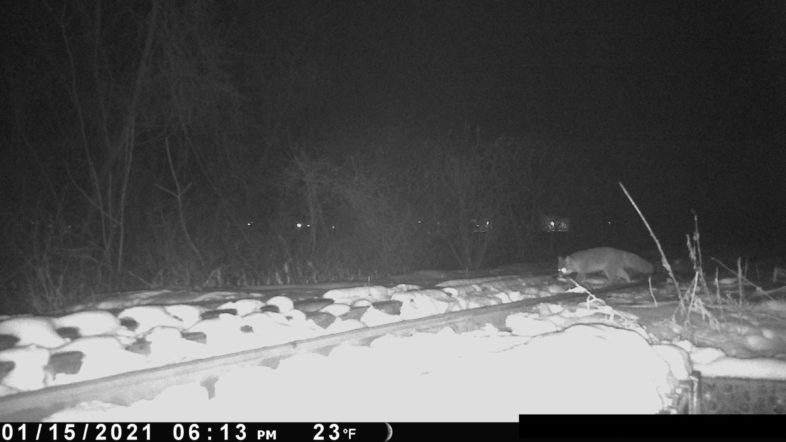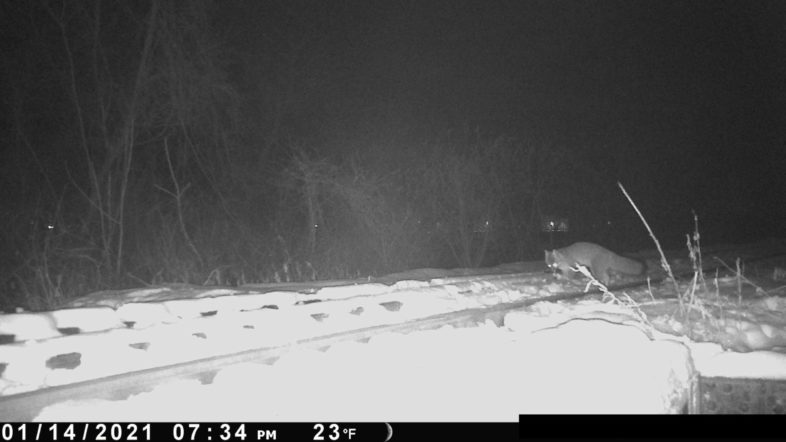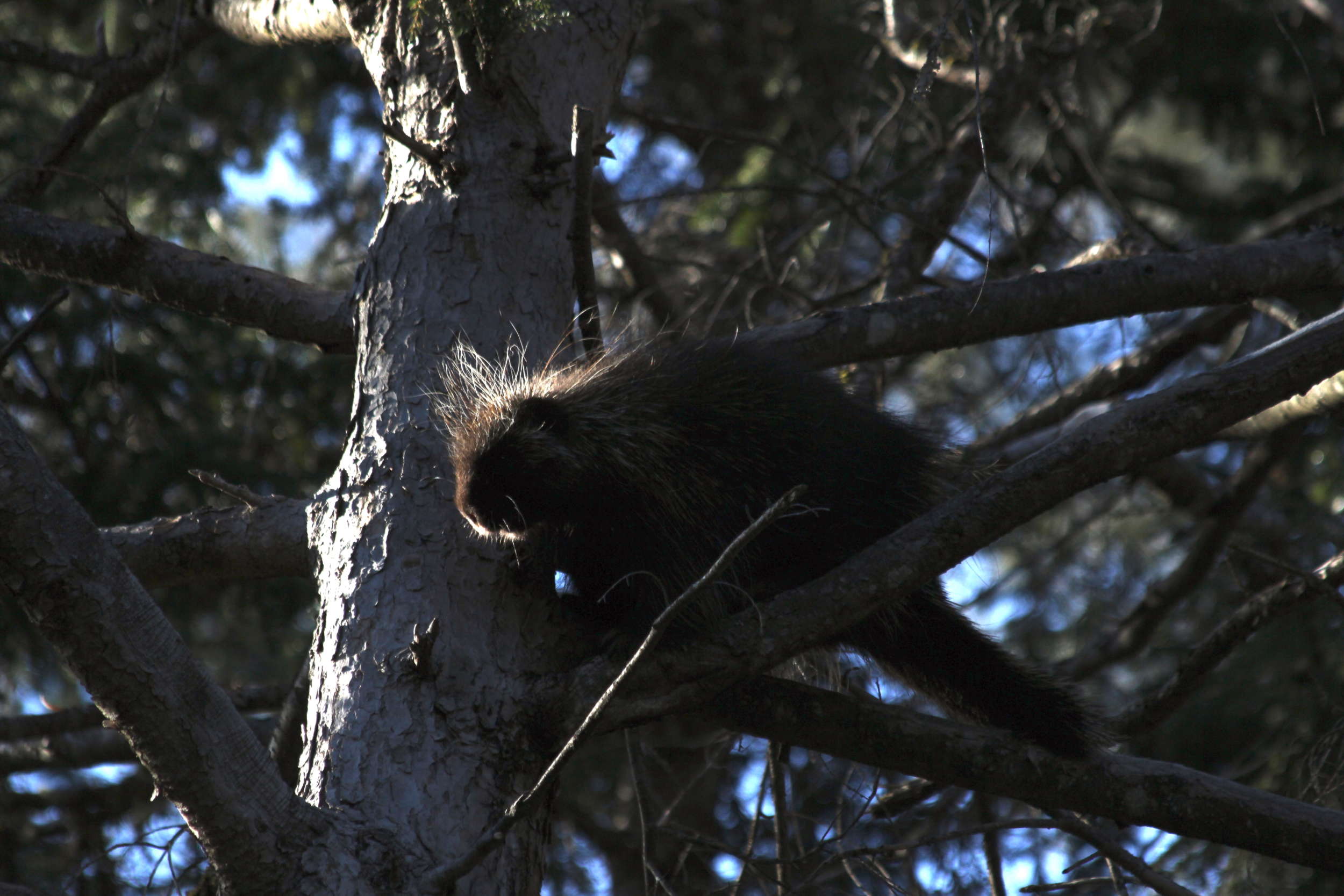
I haven’t seen this bobcat yet, but I can now guess at its home range. © Pete Kerby-Miller
Mammals are on the move. With last week’s snowmelt, deer start to venture away from their sheltered wintering yards. Male skunks are covering several miles each night as their mating season kicks off. Seeing highs in the 60s in the forecast, the mammal writing this blog post is moving skis and snowshoes to the back of the closet and making space to reflect on their progress this winter towards observing every mammal species in Vermont.
Two phenomena dominantly influence winter mammal behavior here: deep snow and a general paucity of food. Each presents both challenges and opportunities for seeing our furred neighbors. Thirty-five of Vermont’s approximately 58 mammal species are smaller than an average gray squirrel, with most of those either hibernating or otherwise spending most of their time below the snow during the winter months. This restricts winter mammal observations to the larger–but not the largest–mammals. Black bears are hibernating and moose are struggling this time of year. I give their likely habitat a wide berth for now.
For those mammals that spend winter above the snow, winter offers great conditions for tracking. More practiced trackers will find good individual prints in any season, but snow allowed me to sometimes quickly get a sense for how nocturnal animals were moving–which was immeasurably helpful for placing night-vision trail cameras to record them on their nightly routines. One favorite observation I made was of a gray fox on the edge of its territory. I saw an area of snow saturated with urine, and pointed a camera at it. When I reviewed the photos I found that a gray fox was returning to that site to scent mark its territory each and every night. Gray foxes are very territorial in their small home ranges–that scent post signs a clear “KEEP OUT” to the nose of other foxes, but I would have been clueless to it without snow cover.


Captured 23 hours apart, these photos illustrate this fox’s nightly territory marking routine. © Pete Kerby-Miller
Using tracks to strategize camera placement was the primary approach for my winter mammal observations, but the one exception was certainly a highlight. It is only for our ungainliest, waddling, armed mammalian herbivore that I even dreamt of following tracks to their maker. I came across distinctive tracks one afternoon after a fresh snowfall. I followed them only a few dozen meters before glancing up to see a porcupine gracing a conifer bough. It seemed quite content there; and upon checking a week later, it hadn’t moved further than one branch over.

The neighborhood porcupine warming up in the last afternoon light. © Pete Kerby-Miller
Porcupines have plenty of bark to eat to get them through the winter, but for many omnivorous and carnivorous mammals, snow cover and dormant plants can mean a lean few months. Monitoring a winter source of food can be really productive for ticking species off my list. Compost piles, bird feeders, and carcasses in particular can be hotspots of activity in cold months. I was glad to photograph both long and short-tailed weasels this winter near a deer carcass. By spring, a weasel’s diet can range widely from emerging insects to small mammals to bird eggs and chicks, so their narrower winter diet was an opportunity to predict where they might show up. I haven’t visited that carcass for awhile, but by now it’s probably attracting even calcium-deficient herbivores.
Yesterday I saw my first-of-the-year chipmunk. Snow is melting, and many insects and annual plants are starting to emerge. With the shifting season, I’m shifting methods from tried and true trail camera monitoring to more diverse and creative ways to observe the remaining ~34 mostly small mammal species. I’ll survey bottles at old homestead dumps for shrew skeletons. I have a bounty set for owl pellets. I set a Google alert to email me anytime someone writes about “feral pig” and “Vermont” on the same page. There’s a fresh molehill by the chicken coop too–maybe I’ll puzzle out another way to see its inhabitant, but for the moment I have an eye on the forecast to set up with my camera and a lawnchair for a backyard stakeout.

Very enjoyable reading, Peter. Thanks for the excellent narrative about your noble adventure. Good teaching points as well.
Thanks Lewis!
Check out this video I captured of a fox and a beaver as well: https://www.youtube.com/watch?v=5MsW_T0TfJw
Fur trappers use pungent scents to lure many curious mammals to traps, and beaver scent glands are a favorite ingredient there. I guess they work while still attached to the beaver too!